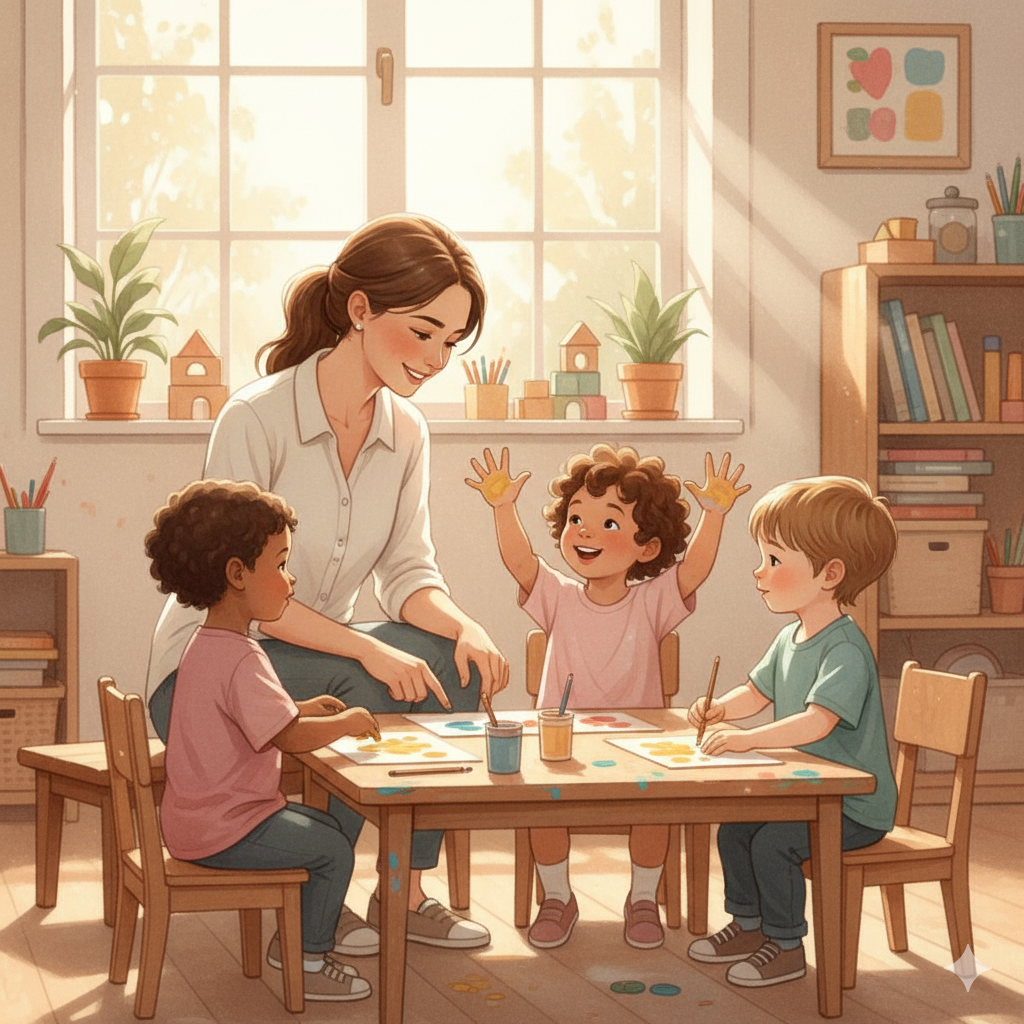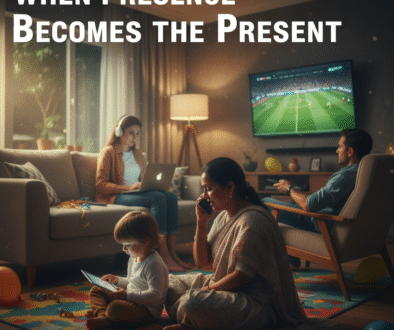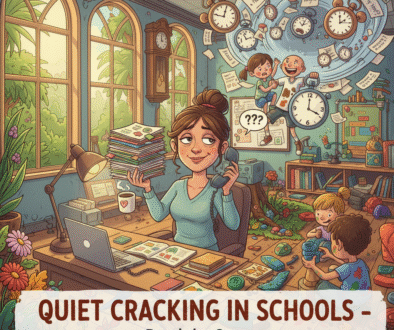The Science of Childhood: What Stays in a Child’s Heart Forever

What Stays in a Child’s Heart Forever
The Warm Hands That Shape the Science of Love
When I started working with very young children, I thought I was there to teach.
Now I know that I was also there to learn — about tenderness, patience, and the enormous, invisible architecture being built every day inside small hearts and curious minds.
Children teach us that development isn’t a straight road; it’s a web of connections. Every smile, every “I see you,” every shared giggle is not decoration — it’s construction. Their brains grow through the music of relationships, through that daily rhythm of “serve and return.”
And yet, even the tiniest ones carry the weight of the world around them. You can feel it sometimes — the silent worry, the extra cling, the eyes that search for reassurance. They may not have words for it, but their bodies and play tell the story. That’s when we, as teachers and caregivers, become translators of safety. We answer the unspoken question — Am I safe here? — with gentle routines, calm presence, and laughter that restores trust.
When we teach children how to understand their feelings, we are not just guiding behaviour — we are shaping their sense of self, the quiet architecture of resilience.
I wrote earlier about how responsibility grows from emotional understanding — not from punishment or reward — in Raising Resilient Children: Responsibility as a Way of Life.
And I keep seeing that truth again and again — not in grand lessons, but in small heartbreaks that could have been healed with attention.
I remember one little girl — sharp, bright, and full of questions that often felt too big for her small shoulders. She carried in her heart the echoes of what I quietly call the parents’ war — those battles fought between adults while the child stands between, wordless but feeling every tremor. When things didn’t go her way, she would throw loud, tearful storms no one could calm for long. We all tried — soft voices, hugs, patience — and when it didn’t work, we silently blamed the situation at home, feeling both helpless and guilty.
Then one day, she drew a picture and wrote a story — a beautiful, strange little world only she could have imagined. I showed it to her father, hoping for the smallest sparkle of pride, a “wow,” maybe even a smile. But he only said, “Put your shoes on, we’ll talk in the car.” Then to me, almost dismissively: “She just copies her sister. The older one reads.”
It wasn’t copied. It was hers.
And more than the story itself — it was her heart trying to speak, to connect, to be seen. That moment broke something quiet inside me. If I, as a grown-up stranger, could feel that sting, what must it have done to her?
Moments like that remind me how easily a child’s light can dim under the shadow of adult noise. They don’t need us to be perfect — just present enough to notice when their heart is whispering beneath the tantrum.
Sometimes I think about what truly shapes a person — not their grades, not their trophies, but the subtle kindness that steadies them through confusion and fear.
And maybe this is what really matters:
Emotional safety is the real curriculum.
A child learns best from someone who sees their heart, not just their performance.
Kindness is not soft — it’s intelligent.
Laughter is the quickest bridge between logic and love.
A calm voice can rewrite a nervous system.
Learning happens when trust does.
The way we respond to mistakes teaches more than the lesson plan.
And warmth — real, quiet, patient warmth — leaves a trace deeper than any grade ever will.
I’ve been in classrooms where theories crumble and real life begins. Where a child’s silence speaks louder than any data chart.
And every time I think I’ve understood the “science” of child development, a tiny hand in mine rewrites everything I thought I knew.
Something I thought about — and this, really, is what makes sense to me.
But the peak of it all, the one truth I keep circling back to, is what I try to capture below.
There’s a kind of science that doesn’t live in labs.
It breathes in classrooms, in conversations, in the quiet spaces between two people trying to understand each other.
It’s the science shaped by gentle hands — not the kind that measure temperature or pressure, but the kind that sense emotion, energy, and life itself.
The Subtle Equation of Connection
I still recall one morning — a little boy, maybe three, sat under the table and refused to come out.
He wasn’t being “defiant.” He was protecting himself from something invisible — a storm that probably didn’t start in that classroom.
I sat next to the table, said nothing, just hummed quietly. After a few minutes, a small hand reached out and rested on my knee.
That was the first lesson of the day — and probably the most important one: connection begins in silence long before it finds its voice.
But maybe that understanding started forming in me long before I ever became a teacher.
When I was in kindergarten, waiting for our Christmas portraits, each girl could hold one of two dolls.
One was tall and beautiful, with dark hair and a long, purple-red gown that swept the floor — the favorite of every girl.
The other had curly blond hair, a knitted top, and trousers — simple, quiet, overlooked.
I looked at her and felt something stir — not pity, but empathy. Like she, too, wanted to belong.
So I chose her. I placed her on my lap, and the teacher smiled, saying softly, “That was beautiful.”
I don’t recall the photograph. I don’t even recall the teacher’s name.
But I still carry that feeling — the warmth of choosing what the world ignores, the tenderness of giving quiet things a place to be seen.
Maybe that was my first small act of emotional understanding — long before I could name it.
The Chemistry of Care
Love has its own variables: time, attention, forgiveness, laughter.
Its constants are harder to measure — presence, gentleness, and the courage to stay when things get uncomfortable.
It’s easy to record data; it’s harder to record tenderness.
But tenderness is data — it just writes itself into the nervous system rather than spreadsheets.
When compassion meets science, the formula changes.
A teacher doesn’t just transfer knowledge — she transmits courage.
A parent doesn’t just nurture a child — they nurture the child’s belief that they matter.
And that belief becomes the foundation of every future discovery.
When Knowledge Starts to Breathe
Education is not a delivery system; it’s a living ecosystem.
You can teach theories of gravity, but if a child never feels safe enough to fall and get back up — what have they really learned?
The caring hands in education don’t just shape intellect; they sculpt resilience, self-worth, and empathy.
I’ve seen it again and again — in Gurgaon’s classrooms where noise, color, and chaos meet emotion and growth.
A child paints a storm and then calmly says, “Now the sun comes out.”
There it is — emotional literacy, art, science, and healing — all happening on a single sheet of paper.
No university lab could design that moment, and yet, it’s pure neuroscience at work.
True educators know this:
Science explains how the world works, but compassion explains why we want to make it work better.
And that “why” is where the art of being human begins.
The Unmeasurable Impact
Long after lessons fade, what stays isn’t the content — it’s the contact.
It’s how someone made you feel seen, capable, enough.
That gentleness becomes invisible scaffolding for everything else you build later in life.
So yes, data matters.
But so do the fingerprints left on the heart.
They’re proof of the quiet science that keeps us human —
the science of love.
And if we ever lose sight of it, maybe we should go back — not to the classroom, but to the memory of someone whose voice softened the edges of our fear.
That’s where all true learning begins.


